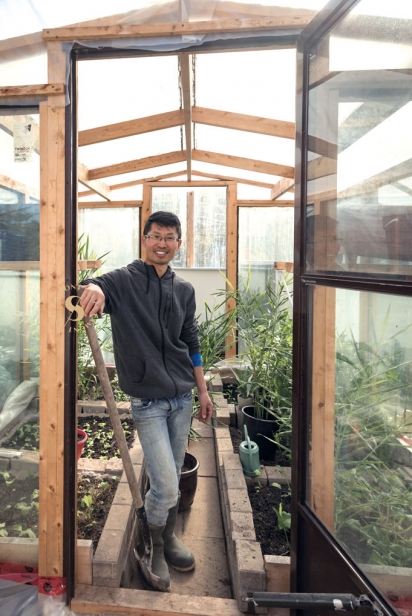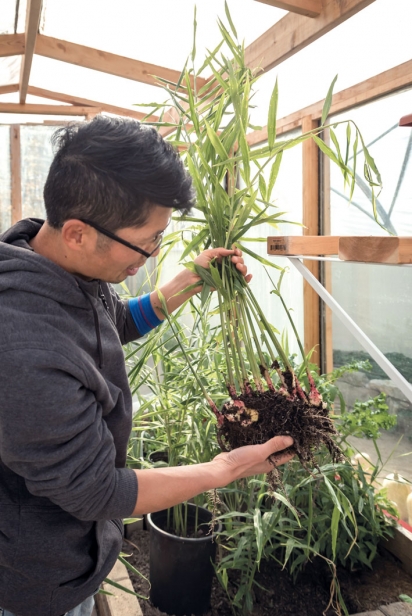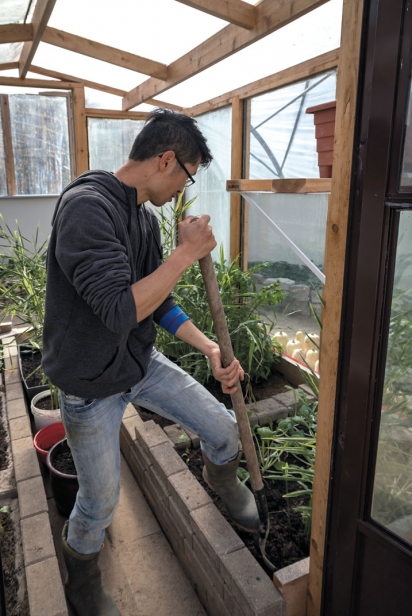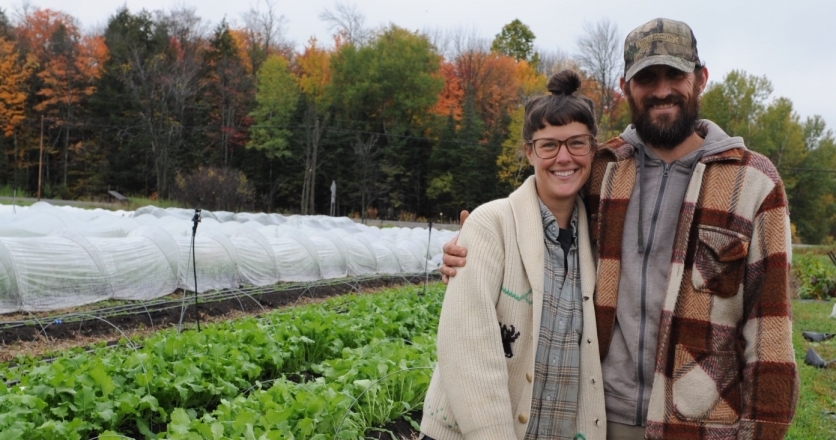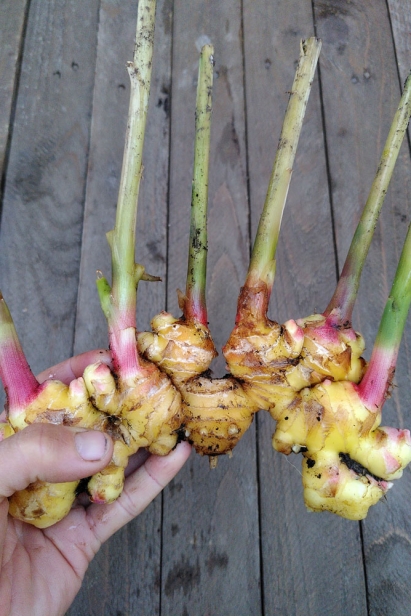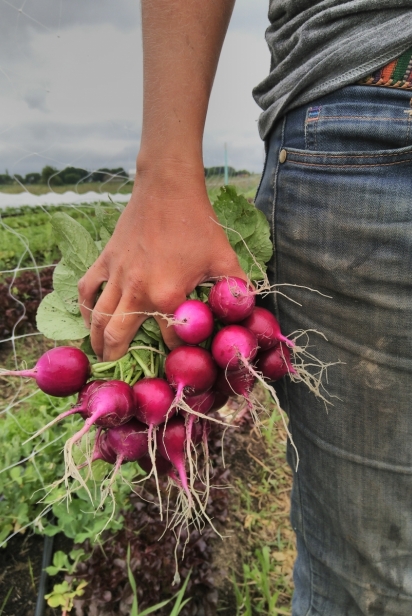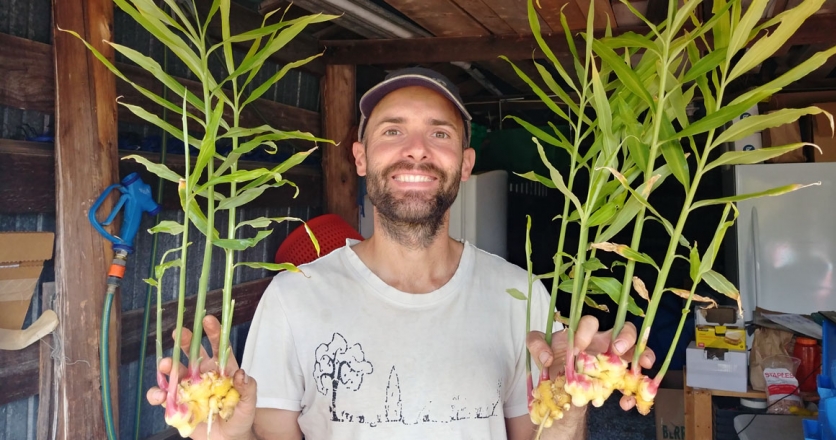Ginger's Hardy Nature
Did you know it’s possible to buy locally grown fresh ginger in Ontario? Strange as it may seem, that tropical, delicate, pink and white rhizome, the root of the flowering ginger plant, can thrive in our brutal climate. It just has to be handled carefully. While the majority of ginger is imported from Peru, Brazil, China, Thailand and Hawaii, keep your eyes peeled for it at late summer farmers’ markets this year.
What’s not to love about this plant? Quite apart from its zingy, warm, slightly spicy taste, it is a veritable panacea. It cures nausea, eases arthritic pain, boosts immune systems as it helps battle germs, aids with indigestion, has antibacterial properties and is an all-round disease-fighter, loaded with antioxidants.
Thanks to the pandemic, demand for ginger has sky-rocketed over the last year, with a shortage in production in China due to flooding in 2020. Prices have risen by as much as 40 per cent in North America. But, all is not lost. Now you can buy it locally.
Long Road Ecological Farm
At Long Road Ecological Farm, just outside Kingston, Xiaobing Shen cultivates the root in his “swimming pool greenhouse.” Shen has converted a round, former above-ground pool into the perfect place to grow vegetables such as bok choy, daikon, Napa cabbage, Chinese greens, luffa (part of the cucumber family), spicy peppers, chard, kale, lettuce, beets and an assortment of herbs and spices. Ginger is among them.
Fresh ginger is tender. It prefers hot and humid conditions; however, it will tolerate temperatures down to five degrees. Its baby shoots are bright green, reminiscent of bamboo palms and it grows vigorously when happy. It’s also extremely versatile.
“The whole plant can be used,” explains Shen. “The leaves and shoots are edible and can be used as a garnish. The plant has great medicinal properties too, as ginger contains potent anti- inflammatory compounds called gingerols. These have been shown to inhibit the growth of cancer cells as well as being an effective pain reliever for arthritis sufferers. It’s also good for motion sickness.”
An added bonus? Ginger looks pretty as a potted house plant. Keep it inside during the harsh Ontario winters and you’ll have a home apothecary at hand, as well as a splash of green in a monochrome landscape.
Elsewhere at his farm, Shen grows butternut squash, elegant long beans, bitter melon and amaranth, among other things. All of these go into his summer CSA vegetable baskets. He raises chickens and a pair of pigs annually, which provide the raw ingredients for his other business, Farm Sum foods.
Farm Sum is a riff on dim sum, traditional Chinese snack foods, typically centred around dumplings. Shen, who is an engineer by training and originally came to Calgary to do graduate studies and research on GPS software, now spends his time growing the raw ingredients that he uses to prepare his steamed buns and dumplings. “I make something every day,” he says, “and I sell as much as I can make.”
Dim sum-making is a painstaking process as each steamed bun and dumpling is prepared by hand. First, Shen makes the dough — be that light and fluffy for the steamed buns, or a rainbow of bright colours tinted by beetroot, spinach or butternut squash for an array of colours for the dumplings — then he starts on the fillings. It’s a multi-day process as the dough for the steamed buns must rise overnight. He offers six types of fillings — typically vegetarian, vegan and pork, spicy and not.
Buns and dumplings can be cooked from fresh or frozen, which is convenient for his clients who drive down from Ottawa, or west from Toronto, to pick up bulk orders. Shen also offers kimchi, Chinese peasant-style fermented vegetables, and cooking classes for groups of up to four people. Classes include hands-on in- struction, snacks and some food to take home at the end. Classes are offered on farm and off-site.
In a certain way, Shen’s life has come full circle. He was born and grew up in rural, mountainous Wuhan province in China. His mother was a peasant farmer, his father an office worker. They worked hard. As did he, both on and off the farm. Shen escaped his farming background to attend university in Wuhan, finishing an engineering degree, which then took him around the world. He’s lived in Munich, Calgary and Toronto. But he’s happiest now on these 36 acres close to Kingston, which he has called home since 2013. “I work 10 hours a day,” he says with a smile, “but I like being in nature. I’m one of the lucky ones as the majority of farmers I know have to find an off-farm job.”
You can find Shen, his vegetables and Farm Sum at the Memorial Centre Farmers' Market in Kingston. At present, due to COVID, orders are made online and are prepared for pickup on market days.
Long Road Ecological Farm
3757 Rd. 38, Harrowsmith, Ont.
longroadecologicalfarm.ca | 613.305.0968 | @farmsumfood
Catena Farm
Every season, Jennie Videto and Chris Lambert plant a couple of new vegetables they have not previously tried at Catena Farm in Shawville. During the summer of 2020, the lottery winners were ginger and lemongrass.
“It was quite successful,” Videto recalls, “although we weren’t aware of how much space the lemongrass would consume, rather overshadowing the ginger.” Nonetheless, they plan to plant ginger for the 2021 season and to include it, alongside lemongrass, in their CSA basket deliveries.
“Years ago, we had no idea it could be grown in a Canadian climate and then we heard about a few small farms in Canada and the U.S. that were successful so we started to discuss growing it in the future when we had tunnels,” Videto says. “[Since it’s] a tropical plant, we just assumed it wouldn’t grow well, but it turns out it is relatively easy. I think in farming it is somewhat rare to be able to produce a ‘new’ local product. After all, we are beholden to our cold climate. Being able to grow something that might be really unexpected to people is pretty cool.”
Last season, the couple simply bought organic ginger from Herb & Spice Shop in Ottawa and started sprouting it indoors. It’s important that the original root be organic, because non-organic ginger is sprayed with a germination inhibitor that will prevent it from sprouting.
After their initial success with the plant, they told their CSA subscribers about it in a fall newsletter, hinting that if all goes well, customers will be receiving it in their baskets this season. “We actually have one wonderful family in our CSA program who calculated the amount of ginger they eat all year and have already put in a request to purchase a large quantity from us,” Videto says.
Ginger is a slightly unusual flavour for anyone raised on a Euro- centric western diet, replete with meat and potatoes. But its slightly peppery, sometimes sweet, infinitely warm spicy flavour has become a supermarket staple and foundation pillar for so much fusion food, that it was only a matter of time before farmers sought to grow it locally. However, fresh ginger, differs from that grown in China, Peru, Brazil and elsewhere, as it is not cured. For Videto, the flavour is different too. “In my opinion, fresh ginger has a more delicate flavour with very subtle sweet and citrusy notes,” she says. “Then, as it dries, it tends to get a little stronger, so the imported stuff is more pungent.”
Quite apart from ginger and lemongrass, Videto and Lambert grow more than 40 different varieties of vegetables for their CSA customers. Both are first-generation farmers, who started out growing for a hobby in a community garden and their own Ottawa backyard. They did this for eight years, increasingly sharing their bounty with friends and family until, “the more we grew our own food, the more we realized that this was what we wanted to do,” Videto recalls. Two years ago, the couple decided to take the plunge and has rented an acre of land in Shawville, Que., while searching for land to buy.
Lambert continues to work full time as a physics technologist at the Ottawa Hospital Cancer Centre, where he has worked for close to 20 years. Videto took courses in environmental studies at Carleton; both knew they wanted to be closer to nature.
Lambert and Videto adhere to a zero-waste and minimal plastic philosophy at Catena Farm. They do not use plastic, other than for their three caterpillar tunnels. All of their seedlings start in soil blocks rather than tiny plastic seed trays, they ask customers to bring their own reusable bags for salad greens, they use jute rather than elastic bands to bundle produce and sell their flower bouquets in kraft paper.
They are also very aware of the depletive effect that intensive gardening can have on soil. They’ve adopted a no-till approach, which means that they disturb the soil as little as possible. “If it’s possible to leave the roots in the ground, we do this,” Videto explains. “We cut everything at the soil line and if there are woody roots left, such as peppers and eggplant, we plant around them or layer in thicker compost and mulch on top, so that they eventually break down. After our first year, when we did till, the difference in biodiversity was huge — so many more worms and other insects.”
Since they work 100-foot-long, 30-inch-wide raised beds, the couple is working at eye level.
“It’s easier to notice everything,” Videto says. The pair also uses mulches to keep the weed burden down along the pathways between the beds, and tarps and cover crops in rotation where necessary, alongside plenty of compost.
The season kicks off indoors in the couple’s basement in March, with powerful lights and a sand table bed, complete with a heated coil running through it, and reflective foil overhead. “It’s very futuristic,” Videto says.
This will allow them to deliver their first CSA in the third week of May. This season, they’ll also be back at the Lansdowne Farmers’ Market.
Catena Farm
921 Hwy. 148, Shawville, Que.
catenafarm.ca | 873.354.5481 | @catenafarm
Nature’s Apprentice Farm
This growing season marks the third that Alberto Suarez-Esteban and Joanna Jack have been attempting to grow ginger on their farm near Packenham. The crop has shown enough promise that this season they intend to plant a full 32-foot-long bed.
First, they’ll buy organic ginger rhizomes to sprout. “It must be kept at 28 degrees or above,” Suarez-Esteban explains. “They do like the chamber to be moist.”
Eventually, the ginger will produce green shoots and leaves, and these shoots grow roots on their own. He’ll then break off the green shoots and transplant them into individual pots so they can continue to grow. These pots will go on on heat mats, to make sure they stay warm and keep the soil moist.
This year, he has built a special sprouting chamber by hooking up an LED, a second-hand crockpot and a thermostat from an old stand-up freezer. The crockpot is what keeps the chamber warm when the lights are off and he tries to keep it full of water, to maintain high humidity. This setup will jump-start the growing process, so that come late May or early June, when all risk of frost has passed, Suarez-Esteban can transplant directly into soil in the greenhouse.
“The more heat, the better, for ginger,” Suarez-Esteban says. “They’re grown in the greenhouse, but also under a second layer of plastic, with drip irrigation installed, using wire hoops.”
Ginger is the crop that is in the ground the longest time at Nature’s Apprentice Farm, because Jack and Suarez-Esteban specialize in fast-growing crops such as salad leaves, radishes and herbs. “It’s an economic decision,” he explains, “because we are farming on a small area of land — just a quarter acre of permanent beds — crops need to be in and out fast.” Suarez- Esteban aims to get three crops from every bed. However, ginger has the highest value, retailing at between $20 and $25 per pound, so it gets to stay.
Last year, Jack and Suarez-Esteban sold fresh ginger to Dandelion Foods in Almonte, as well as restaurants in Arnprior and Carleton Place, including to chef Ian Carswell at Black Tartan Kitchen.
Nature’s Apprentice Farm is also a no-till operation. This means Jack and Suarez-Esteban deal with weeds by fertilizing generously with mushroom compost, they employ tarps over the beds to smother unwanted growth, and, because they don’t disturb the soil, no rogue seeds come to the surface to germinate. Pathways are filled with woodchips to keep the weeds at bay.
“Our focus is on soil biology and health with the aim to produce healthier plants, more nutritious products and fewer pests,” says Suarez-Esteban, who approaches regenerative farming without the use of pesticides or synthetic fertilizers from a scientific background. In the off-season, he teaches ecosystems and environmental change at Carleton University. “My dream has always been to teach in winter and farm in summer,” he explains. “So, I’m headed in the right direction.”
Jack and Suarez-Esteban, who originally came from Spain on a PhD grant to Carleton University, moved to their six acres of land during the winter of 2018. First, they built a cabin to live in and Suarez-Esteban worked two days a week on a neighbouring farm.
The summer of 2020 was their first season of commercial production. They have adopted two sales models. The first is a salad subscription, much like a regular CSA box, but focused on high-quality salad leaves and garnishes such as radishes, baby beets, herbs, cucumbers and cherry tomatoes, among others. The second approach to reaching customers is an email farm membership, which means that Nature’s Apprentice will email on Mondays weekly throughout the growing season, with a list of what’s available. “This way, clients can order exactly what they need,” Suarez-Esteban explains, “and there’s less wastage.”
But back to the ginger. “The beauty of this crop is that you can use the whole plant,” Suarez-Esteban says. “Its skin is very thin and delicate; it’s very juicy. And while taste is subjective, to me it tastes stronger than commercial ginger that has been cured.”
Nature’s Apprentice Farm
112 Lynx Hollow Rd, Pakenham, Ont. | 613.255.5509
naturesapprenticefarm.ca | @natures_apprentice_farm
Growing ginger at home
Ginger is a tropical plant, but it can grow in our northern climate with a little extra care and attention. Here are a few tips to help you succeed.
Start with an organic ginger root.
Cut the ginger into 2-inch chunks, leaving at least one bud on each piece.
Leave out for 2 days to dry the cut end.
Plant the roots in a pot with rich soil that's kept damp, but not wet.
Once the shoots and leaves have developed, you can place the potted ginger outside in the summer. If the temperature reaches 12 C or cooler, it will want to hibernate, so bring it back inside.
Ginger doesn’t like full sun, so pick a spot that offers shade.



